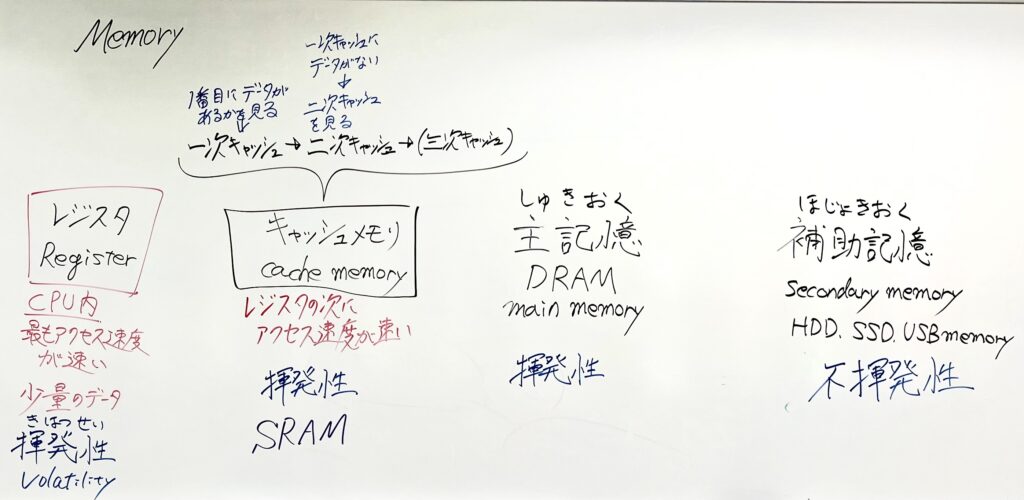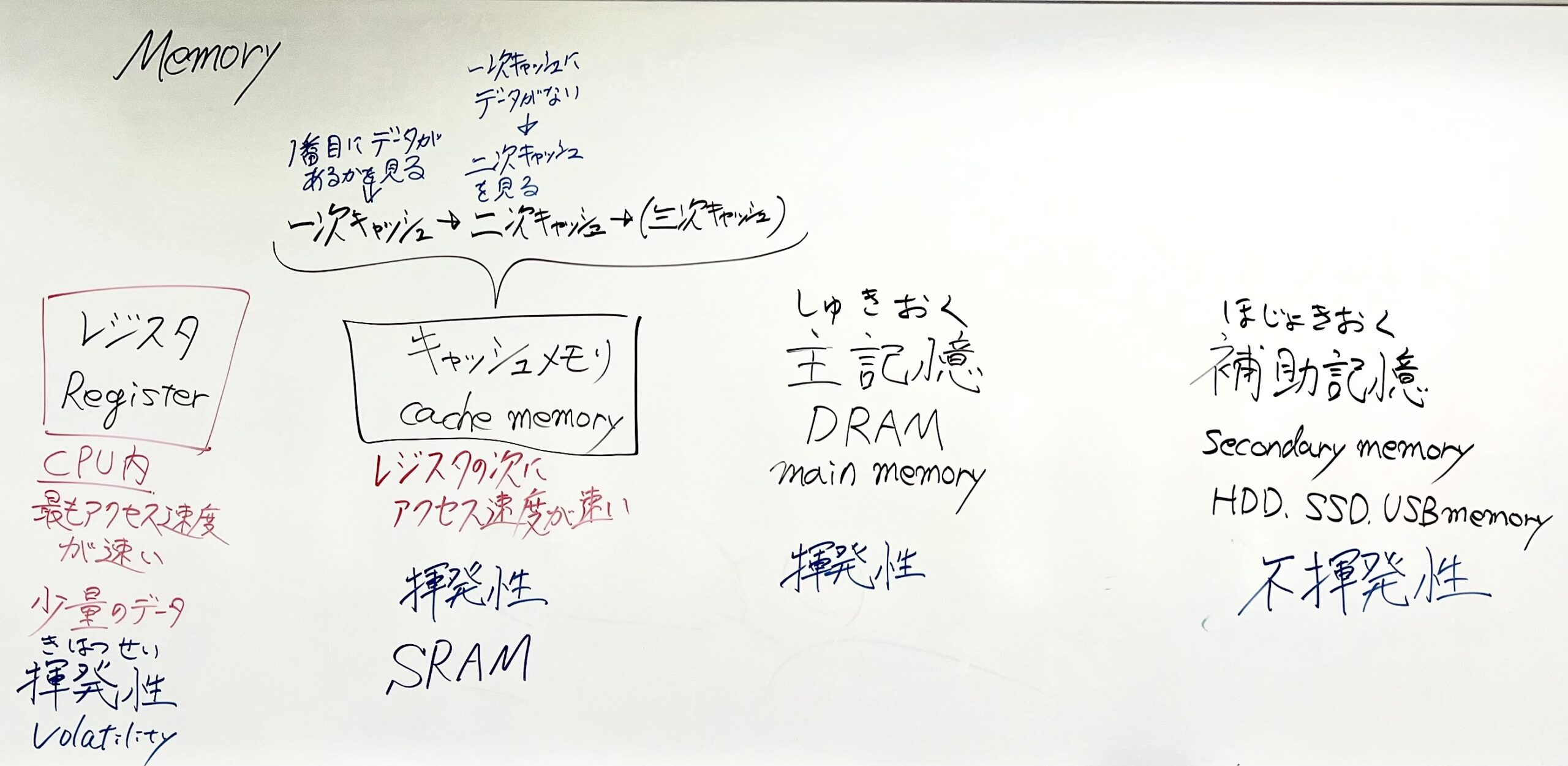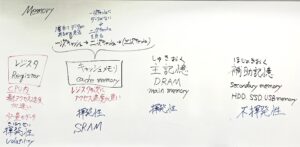レジスタ (Registers):
レジスタは、コンピュータの中で最も高速にアクセスできる小さな記憶場所です。この記憶場所は、コンピュータが今すぐに使う情報を一時的に保管しておく場所です。とても速く動くため、コンピュータはレジスタからすぐに情報を取り出して使うことができます。
レジスタは電気的にデータを書き込む記憶装置です。
A register is a small storage area that is the fastest accessible place in the computer. This storage place is where the computer temporarily stores data that it uses right now. Because it runs so fast, the computer can retrieve information from the register and use it immediately.
A register is a storage device that electrically writes data.
キャッシュメモリ (Cache Memory):
キャッシュメモリは、CPU(コンピュータの脳)のすぐ近くにある速い記憶場所です。このメモリは主にSRAM(Static Random Access Memory)から構成されており、リフレッシュする必要がないため高速です。よく使うデータや命令を一時的に保存し、コンピュータが情報をすぐに取り出せるようにすることで、全体の動作が速くなります。SRAMによるキャッシュの速さがコンピュータをスムーズに動かす手助けをしています。キャッシュメモリは、主記憶装置(DRAM)のアクセス時間を速くするために使用されます。
キャッシュメモリ(SRAM)は電気的にデータを書き込む記憶装置です。
Cache memory is a fast storage location located very close to the CPU (the brain of the computer). This memory consists primarily of SRAM (Static Random Access Memory) and is fast because it never needs to be refreshed. The speed of the cache provided by SRAM helps the computer run smoothly. Cache memory is used to speed up the access time of the main memory (DRAM).
A cache memory (SRAM) is a storage device that electrically writes data.
DRAM(主記憶) (DRAM (main memory)):
DRAMは、コンピュータが使っている間だけ情報を保持する記憶場所です。電源が切れると、保存していた情報は消えてしまいます。このため、コンピュータが電源を入れている間だけ情報を覚えておくことができるのです。
DRAM(主記憶)は電気的にデータを書き込む記憶装置です。
DRAM is a storage location that holds information only while the computer is in use. When the power is turned off, the stored information is lost. This means that information can only be remembered while the computer is powered on.
DRAM (main memory) is a storage device that electrically writes data.
フラッシュメモリ (Flash Memory):
フラッシュメモリは、電源が切れても情報を忘れない特別な記憶場所です。このため、USBメモリやスマートフォン、そしてソリッドステートドライブ(SSD)などでよく使われ、情報を安全に長期間保存できます。
フラッシュメモリは電気的にデータを書き込む記憶装置です。
Flash memory is a special storage location that does not forget data even when the power is turned off. For this reason, it is often used in USB flash drives and smartphones to safely store information for long periods of time.
Flash memory is a storage device that electrically writes data.
SSD(ソリッドステートドライブ) (SSD (Solid State Drive)):
SSDはフラッシュメモリを基にしており、従来のハードディスクドライブよりもデータの読み書きが速いです。また、SSDは動く部分がないため、耐衝撃性に優れていて、消費電力も少ないので、情報を安全に長期間保存できるだけでなく、コンピュータの性能を向上させるのにも適しています。バッテリーの持ちが良いため、特に持ち運び用のデバイスやIoT機器に適しています。
SSD(フラッシュメモリ)は電気的にデータを書き込む記憶装置です。
SSDs are based on flash memory and read and write data faster than traditional hard disk drives. In addition, since SSDs have no moving parts, they are shock resistant and consume less power, making them ideal for not only safely storing information for long periods of time, but also for improving computer performance. Their long battery life makes them particularly suitable for portable devices and IoT equipment.
SSD (flash memory) is a storage device that electrically writes data.
HDD(ハードディスクドライブ) (HDD (Hard Disk Drive)):
HDDは、コンピュータの中で音楽、写真、ビデオなどたくさんのデータを保存する大きな箱です。この箱の中には、薄い円盤がいくつか入っていて、これがとても速く回転します。データは、この回転する円盤に磁石で書き込まれます。円盤が物理的に動くため、落としたりすると壊れやすいです。
HDD(ハードディスクドライブ)は磁気を使用する記憶装置です。
An HDD is a large box in a computer that stores a lot of data, such as music, photos, and videos. Inside this box are several thin disks that spin very quickly. Data is written to these spinning disks with magnets. Because the disks physically move, they are easily broken if dropped.
HDD (hard disk drive) is a storage device that uses magnetism.



